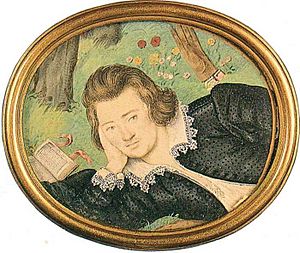George Peele facts for kids
George Peele (born 1556 – died 1596) was an English writer, poet, and dramatist (playwright). He is famous for his plays and is thought by some to have worked with William Shakespeare on the play Titus Andronicus.
Peele's most well-known plays include Edward I, The Old Wives' Tale, The Battle of Alcazar, The Arraignment of Paris, and David and Bethsabe. He also wrote The Troublesome Reign of John, King of England, which Shakespeare later used as a source for his own play, King John.
Contents
Early Life and Education
George Peele was born in City of London and was baptized on July 25, 1556. His father, James Peele, worked as a clerk at Christ's Hospital, a school in central London. His father also wrote books about bookkeeping.
George Peele went to Christ's Hospital for his early education. Later, he studied at Broadgates Hall at the University of Oxford in 1571. He earned his first degree in 1577 and a master's degree in 1579. Around 1580, he moved to London.
Writing for the Queen
Peele was known for his writing skills and was asked to create special performances for important events. In 1585, he wrote a pageant (a public show or parade) for Wolstan Dixie, who was the Lord Mayor of London.
In 1591, he created another pageant for Sir William Webbe, another Lord Mayor. This show, called Descensus Astraeae, honored Queen Elizabeth I. In it, she was praised as 'Astraea', a goddess of justice.
Plays and Their Stories
Peele wrote many plays, often exploring different styles and stories.
The Arraignment of Paris
His play The Arraignment of Paris was a pastoral comedy, meaning it was a lighthearted play set in a countryside. It was performed for Queen Elizabeth I around 1581.
In this play, Jupiter asks Paris to choose the most beautiful goddess among Juno, Pallas, and Venus. Paris gives a golden apple to Venus. The other goddesses complain about his choice. The final decision is given to Diana, who then gives the apple to a nymph named Eliza, which was a clear reference to Queen Elizabeth I.
Historical and Bloody Plays
Peele's play Famous Chronicle of King Edward the First was printed in 1593. This play helped develop historical dramas, leading the way for plays like those by Shakespeare.
Peele is also thought to have written or helped write parts of the intense tragedy Titus Andronicus, which was published as Shakespeare's work. This idea comes partly from Peele's style, which often included dramatic and sometimes violent scenes, as seen in his play The Battle of Alcazar.
The Old Wives' Tale
The Old Wives' Tale (printed in 1595) is a unique play. It's like a play within a play, where characters tell a story that then comes to life. It includes elements of old folk tales and humor.
Biblical Stories
Peele also wrote The Love of King David and fair Bethsabe (printed in 1599). This play is special because it was one of the first Elizabethan plays to be based entirely on stories from the Bible.
Other Writings

Besides plays, George Peele wrote poems for special occasions. One of these is The Honour of the Garter, written for Henry Percy, 9th Earl of Northumberland when he joined the Order of the Garter.
Another famous work is Polyhymnia (1590), which describes a ceremony for Sir Henry Lee of Ditchley, a knight who was Queen Elizabeth I's champion. This work includes the well-known poem A Farewell to Arms. This poem is about a knight pledging his loyalty to the queen as he retires. It was even used as the title for a famous novel by Ernest Hemingway.
Peele's Legacy
George Peele was part of a group of university-educated writers who became playwrights. His friend, Robert Greene, said that Peele was "in some things rarer, in nothing inferior" to other great writers of his time, like Christopher Marlowe and Thomas Nashe.
Peele helped make English plays more dignified and improved the flow of blank verse (poetry without rhyme). However, the most famous parts of his work today are often the songs from his plays, especially from The Old Wives' Tale and The Arraignment of Paris, and the poem A Farewell to Arms. These are still enjoyed and studied today.
My golden locks Time hath to silver turnd.
O Time too swift, O swiftness never ceasing!
My youth 'gainst time and age hath ever spurnd,
But spurnd in vain. Youth waneith by increasing.
Beauty, strength, youth, are flowers but fading seen,
Duty, faith, love, are roots, and ever green.
My Helmet now shall make a hive for bees
And lovers' sonnets turne to holy Psalms.
A man at Armes must now serve on his knees,
And feed on pray'rs, that are Age his alms.
But though from Court to Cottage I depart,
My Saint is sure of mine unspotted heart.
And when I saddest sits in homely cell,
I'll teach my Swaines this Carrol for a song.
Blest be the hearts that wish my Sovereigne well,
Curs'd be the souls that thinke her any wrong.
Goddess, vouchsafe this aged man his right
To be your Beadsman now that was your knight.—George Peele, Polhymnia, 17 November 1590.
Death
George Peele died in 1596 and was buried on November 9, 1596, at St James's Church, Clerkenwell. Today, one of the boarding houses at the modern Horsham campus of Christ's Hospital is named Peele, honoring him and his family's connection to the school.
List of Plays
Here are some of the plays attributed to George Peele:
- Sir Clyomon and Sir Clamydes (1577) (attributed)
- The Arraignment of Paris (1581)
- The Troublesome Reign of King John (1589)
- Mucedorus (1590) (attributed)
- The Battle of Alcazar (1591)
- Titus Andronicus (1592) (attributed; possibly co-written with Shakespeare)
- The Famous Chronicle of King Edward the First (1593)
- The Love of King David and Fair Bethsabe (1594)
- The Old Wives' Tale (1595)

